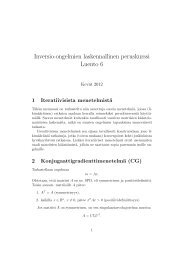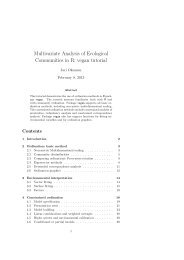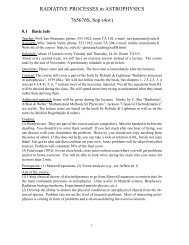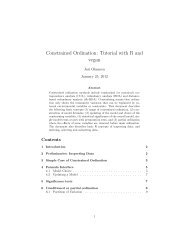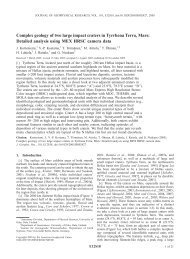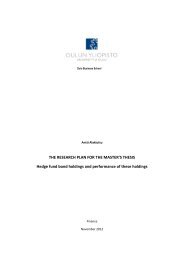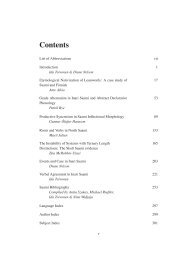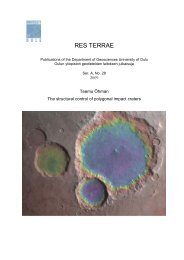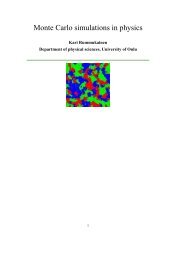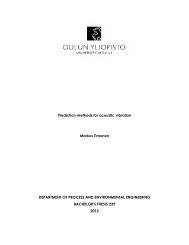Juha Köykkä - Oulu
Juha Köykkä - Oulu
Juha Köykkä - Oulu
- TAGS
- juha
- oulu
- cc.oulu.fi
You also want an ePaper? Increase the reach of your titles
YUMPU automatically turns print PDFs into web optimized ePapers that Google loves.
Res Terrae, Ser. A 32, J. <strong>Köykkä</strong>, Sedimentology of the Mesoproterozoic Telemark basin-fills, South Norway: implications for<br />
sedimentation processes, depositional environments and tectonic evolution<br />
Major shear and fault zones in divide it into blocks (thick black lines). Insert (Baltica/East European<br />
Craton): TESZ: Trans-European Suture Zone. (B) Close-up view of southwest Fennoscandia<br />
showing the Telemark block and the Telemark supracrustal rocks (modified from Bingen et al.,<br />
2003). Other possible correlative supracrustal formations are shown in dark green.<br />
3.2 Regional correlation of sedimentary-dominated successions<br />
Smaller occurrences of sedimentary-dominated successions are found outside of the Tele-<br />
mark block (Fig. 2B) in the Rogaland-Hardangervidda block (west of the Telemark block),<br />
the Bamble block (south of the Telemark block) and the Kongsberg block (east of the Te-<br />
lemark block) (Bugge, 1943; Dons 1960a, 1960b). In these areas, the rocks are commonly<br />
intensively deformed, and sedimentary structures are obliterated, but some of these can po-<br />
tentially correlated with the Telemark supracrustal rocks. Torske (1985) correlated the Da-<br />
la sandstone in western Sweden and easternmost south Norway with the Vindeggen Group<br />
(part of the Telemark supracrustal rocks). Both units are dominated by sandstone and are<br />
heavily intruded by diabase dykes. A study by Bingen et al. (2001) compared detrital zir-<br />
con U-Pb data from several quartzites in Norway (with the exception of the Dala sand-<br />
stone). These sediments contain abundant Paleoproterozoic zircon age modes peaking at<br />
ca. 1.9–1.8 Ga with a significant Archean mode. The youngest grain was not younger than<br />
ca. 1.4 Ga. Although their datasets did not contain a statistically robust number of observa-<br />
tions, their results suggested a common Archean-Paleoproterozoic source for the detritus<br />
and a surprisingly low (ca. 1.5 Ga) signature, given that rocks of this age are widely abun-<br />
dant at present-day erosional levels. The age distribution of detrital zircons in the Vin-<br />
deggen Group display similar age distribution than quartzite samples from the Kragero<br />
and Modum complexes (de Haas et al., 1999, Bingen et al., 2001), and possible indi-<br />
cate that they are correlative and deposited along the same continent. Andersen et al.,<br />
(2004) suggested that Blefjell quartzite unit (east from the Telemark) possible correlate<br />
with the Lifjell Group in the Telemark (Fig. 2B). The Blefjell quartzite unit consist la-<br />
minated and cross-bedded sandstones deposited between ca. 1155 and 1145 Ma (An-<br />
dersen et al., 2004). The stratigraphic position of the Dala sandstone indicates that they<br />
are younger than 1.67 Ga. The occurrence of 1.71 Ga zircons in the quartzite of the<br />
Hallingdal complex, corresponding to the Dala granitoids and porphyries, is compati-<br />
ble with a Fennoscandia origin of the Hallingdal complex and is suggestive of correla-<br />
tion between them (Bingen et al., 2001).<br />
28



